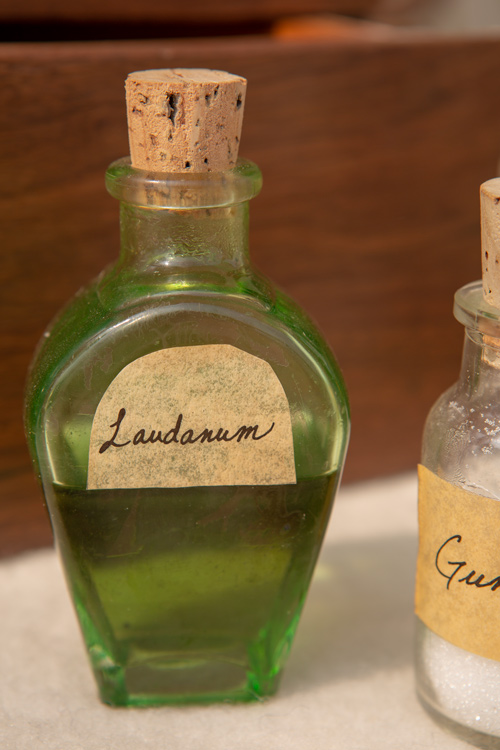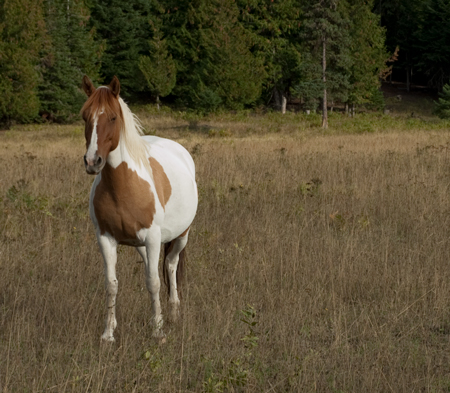At Fort Clatsop, the captains describe Indian horses and their availability for trade. They also list the other four-footed mammals they have encountered. Pvt. Gibson is carried from the salt makers‘ camp, and his medical treatment begins.
The Quadrupeds of This Country
by Yellowstone Public Radio[1]Originally aired weekdays by Yellowstone Public Radio during the Bicentennial observance of 2003-2006. Narrated by Hal Hansen. Scripts by Whit Hansen and Ed Jacobson. Produced by Leni Holliman. © … Continue reading
Laudanum
Historical interpretation by John W. Fisher and presented by the Lewis and Clark Honor Guard of Great Falls. Photo © 2017 by Kristopher K. Townsend. Permission to use granted under the Creative Commons Attribution-Share Alike 4.0 International license.
Gibson Returns
3 P. M. Bratten arived from the Saltworks, and informed us that Serjt. Pryor and party were on their way with gibson in a litter.
After Dark Sergt. Pryor arrived with Gibson. we are much pleased in findeing him by no means as ill as we had expected.
—William Clark
Gibson’s Illness
we beleive his [Gibson‘s] disorder to have orriginated in a violent cold which he contracted in hunting and pursuing Elk and other game through the swams and marshes about the salt works. he is nearly free from pain tho’ a gooddeel reduced and very languid. we gave him broken dozes of diluted nitre and made him drink plentifully of sage tea, had his feet bathed in warm water and at 9 P. M. gave him 35 drops of laudanum.
—Meriwether Lewis
Spotted Appaloosa
Weippe Prairie. © 7 June 2009 by Kristopher K. Townsend. Permission to use granted under the Creative Commons Attribution-Share Alike 4.0 International license.
Pied Horse
Weippe Prairie. © 9 September 2009 by Kristopher K. Townsend. Permission to use granted under the Creative Commons Attribution-Share Alike 4.0 International license.
Indian Horses in the PNW
we have leant the following nations reside (viz) the Sosone or snake Indians [Lemhi Shoshones], the Chopunnish [Nez Perce], sokulks [Wanapums], Cutssahnims, Chymnapums [both Yakamas], Ehelutes [Wascos and Wishrams], Eneshuh [likely Teninos] & Chilluckkittequaws [The Chilluckittequaws]. all of whom enjoy the bennefit of that docile, generous and valuable anamal the horse, and all of them except the three last have immence numbers of them.
—Meriwether Lewis
Spotted and Pied Horses
the larger portion are of an uniform colour with stars snips and white feet, or in this rispect marked much like our best blooded horses in virginia, which they resemble as well in fleetness and bottom as in form and colours. some of those horses are pided [pied] with large spots of white irregularly scattered and intermixed with the black brown bey or some other dark colour
—Meriwether Lewis
Indian Mules
They have also a great number of mules, which among the Indians I find are much more highly prized than horses. the mules in the possession of the Indians are principally stolen from the Spaniards of Mexeco; they appear to be large and fine such as we have seen.
—Meriwether Lewis
Local Quadrupeds
The quadrupeds of this country from the Rocky Mountains to the pacific Ocean are 1st the domestic animals, consisting of the horse and the dog only; 2cdly the native wild animals, consisting of the Brown white or grizly bear, (which I beleive to be the same family with a mearly accedental difference in point of colour) the black bear, the common red deer, the black tailed fallow deer, the Mule deer, Elk, the large brown wolf, the small woolf of the plains, the large wolf of the plains, the tiger cat, the common red fox, black fox or fisher, silver fox, large red fox of the plains, small fox of the plains or kit fox, Antelope, sheep, beaver, common otter, sea Otter, mink, spuck, seal, racoon, large grey squirrel, small brown squirrel, small grey squirrel, ground squirrel, sewelel, Braro, rat, mouse, mole, Panther, hare, rabbit, and polecat or skunk.
—Meriwether Lewis
Weather Diary
aspect of the weather at rise
Wind at rise
aspect of the weather at 4 OC1 P.M. Wind at 4 O’Clock P.M. cloudy after rain & fair S cloudy and rain & fair S. W fair most of last night hard frost this morning. the ground white with it. The robbin returned and were singing which reminded me of spring. some other small birds passed on their flight from the South, but were so high that we would not distinguish of what kind they were. the robbin had left this place before our arrival in November.
—Meriwether Lewis[2]To assist the reader, the editor of this web page has omitted the “Day of ye Month” column and spelled out some abbreviations.
Experience the Lewis and Clark Trail
The Lewis and Clark Trail Experience—our sister site at lewisandclark.travel—connects the world to people and places on the Lewis and Clark Trail.
Plan a trip related to February 15, 1806:

Fort Clatsop is a High Potential Historic Site along the Lewis and Clark National Historic Trail managed by the U.S. National Park Service. The site is managed by the Lewis and Clark National and State Historic Parks.
Notes
| ↑1 | Originally aired weekdays by Yellowstone Public Radio during the Bicentennial observance of 2003-2006. Narrated by Hal Hansen. Scripts by Whit Hansen and Ed Jacobson. Produced by Leni Holliman. © 2003 by Yellowstone Public Radio. |
|---|---|
| ↑2 | To assist the reader, the editor of this web page has omitted the “Day of ye Month” column and spelled out some abbreviations. |





